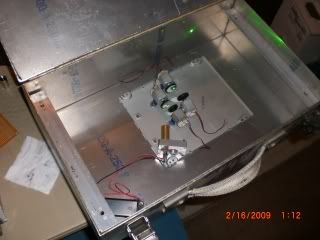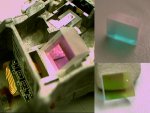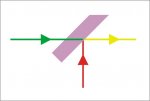Hi, I am new to lasers and I would like to build my first RGY spirograph. Over the past week I read a lot of articles about lasers and I think that I am ready. 
This picture shows how I would like it to look:

I will start with the lasers.
The lasers that I chose are 5mW green module DealExtreme: $15.95 Geniune New Wish 5mW Green Laser Module (5V) and 20mW red module DealExtreme: $7.89 20mW 650nm Red Laser Module (3~4.5V 12mm) I know that the green one has a driver already, so that means that I can you just plug it on a 5V source, but the red module seems to be without a driver. That means that I need to buy one separately right? I looked at the lava driver but I don’t think that I need a driver for over $20 when I have a module for $7.89. Is there any other cheaper driver that I can use? Also the description of the red laser says that it needs 3~4.5V. How do I get how many mA does it need?
The second things are the mirrors and filters.
I found this dichroic mirror (reflects green ,passes red) to be the cheapest I could find DIY Laser Show , but I still think that its quite expensive. Do you know any other shop where I can get it for a cheaper price? I also found out that edmundoptics are one of the best on the market. So I found this dichro( reflects red, passes green) 45° Reflective Dichroic Color Filters - Edmund Optics and I wonder, is there really a difference between these dichros except the brand? I would also like to know if it matters if the mirror reflects red and passes green or reflects green and passes red? Which one is better? Also I read that the front surface mirrors are the best (Q: What’s the difference between rear and front mirror? Why is front better?) so I chose these Optotronics Product Details . I hope they will work fine, but if you have any other cheaper and better solution please tell me.
The last think is the IR filter, which if I understand is a filter that blocks the harmful IR waves from green lasers. I want to have my laser experiments save so I found these IR filters Optotronics Product Details and Commercial Quality Heat Absorbing Glass - Edmund Optics . When I looked at the description it said that it absorbs 80% 800-1000nm wavelengths (1st one) and the other 60% from1700 to 2500nm(2nd one) . :huh:This is a huge difference, which one is better? Which wavelength are more harmful? The prices are also totally opposite the one from Edmund costs 24.50 for 102x127mm and the other one $0.99 for 25mm square.
Oh I almost forgot: Are these modules reliable and do I need to heat sink them if I would use them let’s say 2 hours in a row?
That’s all Please help me.
Please help me. Thank you very much :thanks:
Thank you very much :thanks:
This picture shows how I would like it to look:

I will start with the lasers.
The lasers that I chose are 5mW green module DealExtreme: $15.95 Geniune New Wish 5mW Green Laser Module (5V) and 20mW red module DealExtreme: $7.89 20mW 650nm Red Laser Module (3~4.5V 12mm) I know that the green one has a driver already, so that means that I can you just plug it on a 5V source, but the red module seems to be without a driver. That means that I need to buy one separately right? I looked at the lava driver but I don’t think that I need a driver for over $20 when I have a module for $7.89. Is there any other cheaper driver that I can use? Also the description of the red laser says that it needs 3~4.5V. How do I get how many mA does it need?
The second things are the mirrors and filters.
I found this dichroic mirror (reflects green ,passes red) to be the cheapest I could find DIY Laser Show , but I still think that its quite expensive. Do you know any other shop where I can get it for a cheaper price? I also found out that edmundoptics are one of the best on the market. So I found this dichro( reflects red, passes green) 45° Reflective Dichroic Color Filters - Edmund Optics and I wonder, is there really a difference between these dichros except the brand? I would also like to know if it matters if the mirror reflects red and passes green or reflects green and passes red? Which one is better? Also I read that the front surface mirrors are the best (Q: What’s the difference between rear and front mirror? Why is front better?) so I chose these Optotronics Product Details . I hope they will work fine, but if you have any other cheaper and better solution please tell me.
The last think is the IR filter, which if I understand is a filter that blocks the harmful IR waves from green lasers. I want to have my laser experiments save so I found these IR filters Optotronics Product Details and Commercial Quality Heat Absorbing Glass - Edmund Optics . When I looked at the description it said that it absorbs 80% 800-1000nm wavelengths (1st one) and the other 60% from1700 to 2500nm(2nd one) . :huh:This is a huge difference, which one is better? Which wavelength are more harmful? The prices are also totally opposite the one from Edmund costs 24.50 for 102x127mm and the other one $0.99 for 25mm square.
Oh I almost forgot: Are these modules reliable and do I need to heat sink them if I would use them let’s say 2 hours in a row?
That’s all
Last edited:









